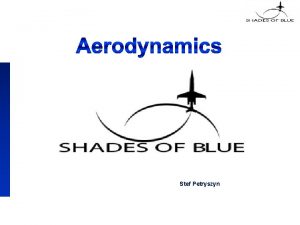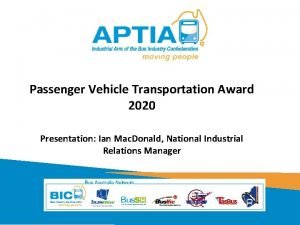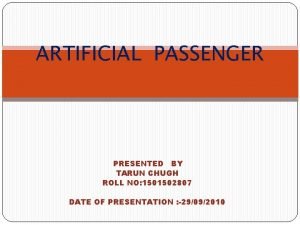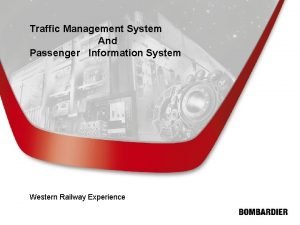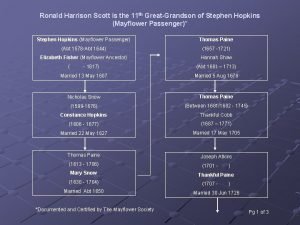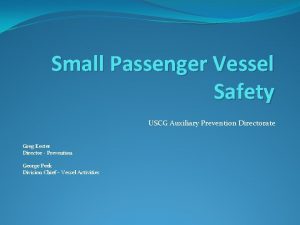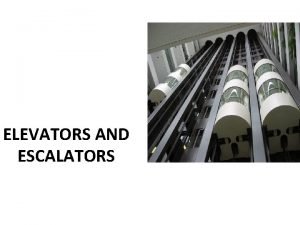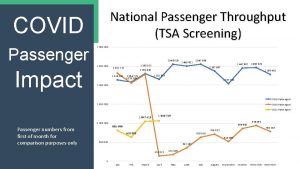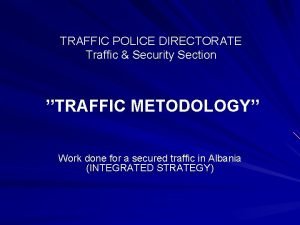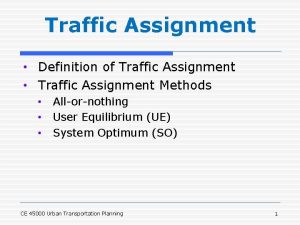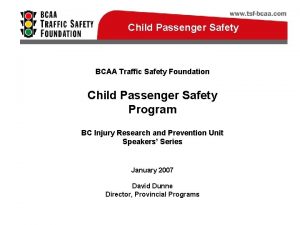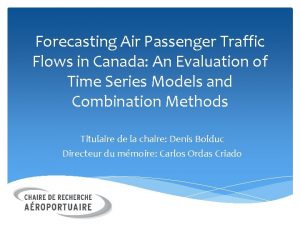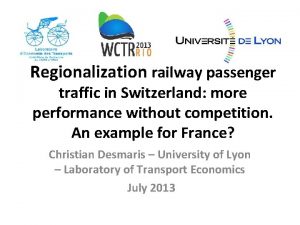A New Concept for Passenger Traffic in Elevators




















- Slides: 20

A New Concept for Passenger Traffic in Elevators Juha-Matti Kuusinen, Harri Ehtamo Helsinki University of Technology Janne Sorsa, Marja-Liisa Siikonen KONE Corporation S ystems Analysis Laboratory Helsinki University of Technology 1

Introduction • Reliable simulation and forecasting require accurate traffic statistics • Our new concept, passenger journey, enables: – Floor-to-floor description of the traffic – Estimation of the passenger arrival process S ystems Analysis Laboratory Helsinki University of Technology 2

Passenger Journeys • Passenger journey: – A batch of passengers that travels from the same departure floor to the same destination floor in the same elevator car • Elevator trip: – Successive stops in one direction with passengers inside the elevator S ystems Analysis Laboratory Helsinki University of Technology 3

Passenger Traffic Measurements • Passenger transfer data • Call data Passenger exited the elevator Passenger entered the elevator S ystems Analysis Laboratory Helsinki University of Technology 4

Log File • Elevator group control combines the data into a S ystems Analysis Laboratory Helsinki University of Technology 5

Passenger Journey Algorithm • Stops are read one by one • A linear system of equations is defined for each elevator trip • Conservation of passenger flow in an elevator trip S ystems Analysis Laboratory Helsinki University of Technology 6

Passenger Journeys: Example • Passenger journey of batch size 2 from departure floor A to destination floor C • Passenger journey of batch size 3 from departure floor A to destination floor D S ystems Analysis Laboratory Helsinki University of Technology 7

Batch Arrival Times • Assumption: – Batch arrival times correspond to call registration times • Checked using call response time: – Time from registering a call until the serving elevator starts to open its doors at the departure floor S ystems Analysis Laboratory Helsinki University of Technology 8

Passenger Traffic Statistics and Traffic Components • Given time period, e. g. day, is divided into K intervals [tk, tk+1], k=0, 1, . . . , K-1 • Number of passengers per interval, i. e. intensity, is recorded S ystems Analysis Laboratory Helsinki University of Technology 9

Passenger Journey Statistics • Intensity of b sized batches from departure floor i to destination floor j is – k defines the interval [tk, tk+1] • Departure-destination floor matrix: – Contains traffic components as subsets S ystems Analysis Laboratory Helsinki University of Technology 10

Case Study • Office building: – 16 floors – Two entrances – Two tenants S ystems Analysis Laboratory Helsinki University of Technology 11

Daily Number of Passenger Journeys • No distinctive outliers • No apparent weekly or monthly patterns • Average number of passenger journeys same regardless of the week • No traffic during weekends S ystems Analysis Laboratory Helsinki University of Technology 12

Measured Departure-Destination Floor Matrix: Lunch Time • Average of 79 weekdays • All batch sizes considered • Heavy incoming and outgoing traffic S ystems Analysis Laboratory Helsinki University of Technology 13

Measured Departure-Destination Floor Matrix: Whole Day • The two tenants are recognized S ystems Analysis Laboratory Helsinki University of Technology 14

Batch Size in Outgoing Traffic • Many batches bigger than one passenger • Resemble the geometric distribution S ystems Analysis Laboratory Helsinki University of Technology 15

Batch Arrival Test • Null hypothesis: – Batch arrivals form a Poisson-process within five minutes intervals • Uniform conditional test for Poissonprocess (Cox and Lewis 1966) – Under the null hypothesis the transformed arrival times are independently and uniformly distributed over [0, 1] S ystems Analysis Laboratory Helsinki University of Technology 16

Test Results • In total 16 tests, 9 accepted null hypotheses: – Six tests rejected independence – One test rejected uniformity • Inter-arrival times close to exponential: – Independence test give only a rough guide • Fit of batch arrivals to Poisson-process: – Outgoing: good – Incoming and interfloor: reasonable S ystems Analysis Laboratory Helsinki University of Technology 17

Call Response Time S ystems Analysis Laboratory Helsinki University of Technology 18

Conclusion and Future Research • Passenger journeys enable detailed description of passenger traffic in elevators • For example, in outgoing traffic: – Batch arrivals form a Poisson-process – Batch size is often bigger than one passenger • Future research: – Automatic recognition of building specific traffic patterns – Forecasting in elevator group controls – Measurements from other buildings S ystems Analysis Laboratory Helsinki University of Technology 19

References • Alexandris, N. A. 1977. Statistical models in lift systems. Ph. D. thesis, Institute of Science and Technology, University of Manchester, England • Barney, G. C. 2003. Elevator Traffic Handbook. Spon Press • Cox, D. R. , P. A. W. Lewis. 1966. The Statistical Analysis of Series of Events. Methuen & Co Ltd. • Siikonen, M-L. 1997. Planning and control models for elevators in high-rise buildings. Ph. D thesis, Systems Analysis Laboratory, Helsinki University of Technology, Finland • Siikonen, M-L. , T. Susi, H. Hakonen. 2001. Passenger traffic simulation in tall buildings. Elevator World 49(8) 117 -123 • Sorsa, J. , M-L. Siikonen, H. Ehtamo. 2003. Optimal control of double-deck elevator group using genetic algorithm. International Transactions in Operational Research 10(2) 103114 S ystems Analysis Laboratory Helsinki University of Technology 20
 Incomina
Incomina Intelligent traffic solutions
Intelligent traffic solutions Warwick james elevator principle
Warwick james elevator principle Principles of dental elevators
Principles of dental elevators Single family home elevators
Single family home elevators Elevators definition
Elevators definition Vex pro sprocke
Vex pro sprocke Residential elevators florida
Residential elevators florida Passenger vehicle transportation award 2020 pay rates
Passenger vehicle transportation award 2020 pay rates Boarding or alighting
Boarding or alighting Artificial passenger
Artificial passenger 15-passenger van quiz answer key
15-passenger van quiz answer key Passenger management system
Passenger management system Stephen hopkins mayflower passenger grandchildren
Stephen hopkins mayflower passenger grandchildren Dodo passenger pigeon
Dodo passenger pigeon Passage passenger power
Passage passenger power Confirmed revenue passenger oversales
Confirmed revenue passenger oversales Uninspected passenger vessel
Uninspected passenger vessel Passenger vessel safety act of 1993
Passenger vessel safety act of 1993 Your passenger jammed his finger in the door of your m1114
Your passenger jammed his finger in the door of your m1114 Safest 15 passenger van
Safest 15 passenger van





